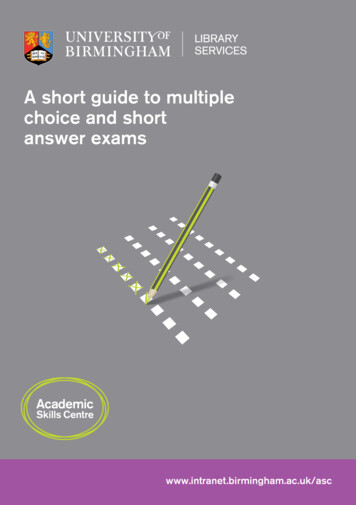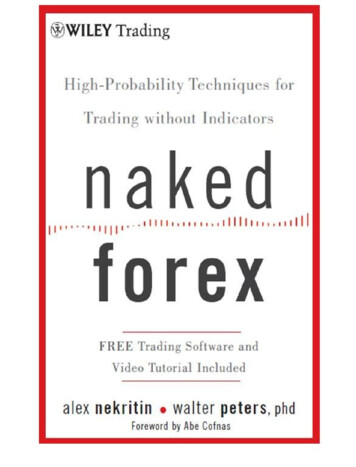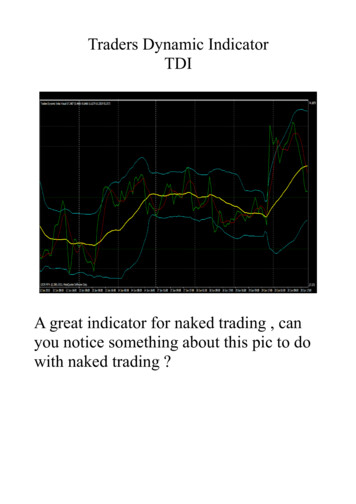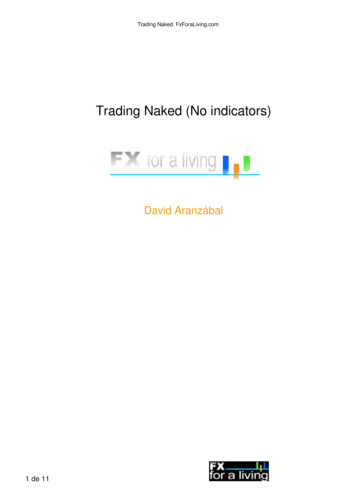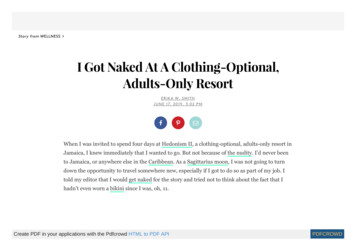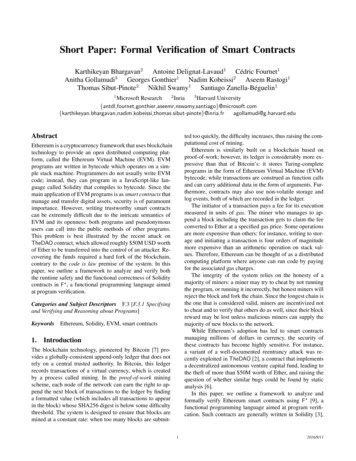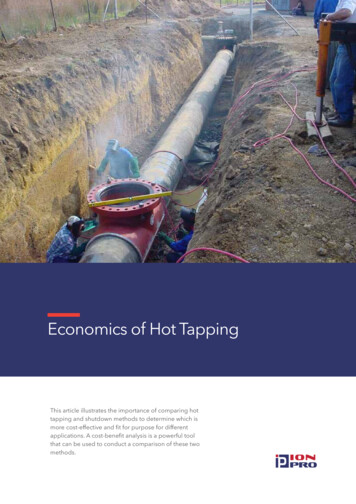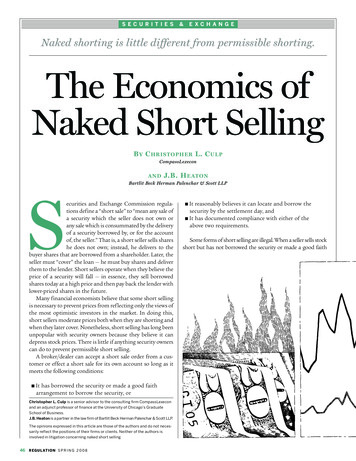
Transcription
S EC U R I T I E S&E XC H A N G ENaked shorting is little different from permissible shorting.The Economics ofNaked Short SellingB Y C HRISTOPHER L. C ULPCompassLexeconANDJ.B. H EATONBartlit Beck Herman Palenchar & Scott LLPSecurities and Exchange Commission regulations define a “short sale” to “mean any sale ofa security which the seller does not own orany sale which is consummated by the deliveryof a security borrowed by, or for the accountof, the seller.” That is, a short seller sells shareshe does not own; instead, he delivers to thebuyer shares that are borrowed from a shareholder. Later, theseller must “cover” the loan — he must buy shares and deliverthem to the lender. Short sellers operate when they believe theprice of a security will fall — in essence, they sell borrowedshares today at a high price and then pay back the lender withlower-priced shares in the future.Many financial economists believe that some short sellingis necessary to prevent prices from reflecting only the views ofthe most optimistic investors in the market. In doing this,short sellers moderate prices both when they are shorting andwhen they later cover. Nonetheless, short selling has long beenunpopular with security owners because they believe it candepress stock prices. There is little if anything security ownerscan do to prevent permissible short selling.A broker/dealer can accept a short sale order from a customer or effect a short sale for its own account so long as itmeets the following conditions: It has borrowed the security or made a good faitharrangement to borrow the security, orChristopher L. Culp is a senior advisor to the consulting firm CompassLexeconand an adjunct professor of finance at the University of Chicago’s GraduateSchool of Business.J.B. Heaton is a partner in the law firm of Bartlit Beck Herman Palenchar & Scott LLP.The opinions expressed in this article are those of the authors and do not necessarily reflect the positions of their firms or clients. Neither of the authors isinvolved in litigation concerning naked short selling46 R EG U L AT I O N S P R I N G 2 0 0 8It reasonably believes it can locate and borrow thesecurity by the settlement day, and It has documented compliance with either of theabove two requirements. Some forms of short selling are illegal. When a seller sells stockshort but has not borrowed the security or made a good faith
arrangement to borrow the security, or does not reasonablybelieve it can borrow the security by the settlement day, the shortseller is probably engaged in impermissible “naked” short selling.Naked short selling has been the focus of an increasingnumber of lawsuits. One plaintiffs’ lawyer prosecuting thesesuits argues that the practice is “the largest commercial fraudin U.S. history, involving hundreds of billions of dollars.”Outside the legal community, those decrying the practice rangefrom fervently opinionated individual investors to the U.S.Chamber of Commerce, which asked the sec in January 2007to take additional steps to stop naked short selling. Regulatorsand exchanges have shown a willingness to crack down onalleged violations of prohibitions on naked short selling.Despite the cries of alarm, we believe that naked short sellingis unlikely to have significant detrimental effects on capital markets. In this article, we will first examine the relevant economicsand regulation, and then argue that, from an economic perspective, naked shorting is little different from traditional shorting.MORGAN BALLARDTHE ECONOMICS OF SHORT SELLINGThe conventional wisdom is that short selling drives down theprice of the stock being sold. The sec often receives excitedopposition to the practice of short selling, much of whichinvokes accusations of conspiracy theory and nearly religiousfervor against short selling in general and naked short sellingin particular. At the same time, financial economists long havebeen skeptical of the value of regulations that constrain speculative short selling because of a conviction that short sale constraints may allow overpriced securities to remain overpriced.THE GOOD SIDEPrices are socially valuable signals. Short sell-ing can correct irrational overpricing if and when it occurs and,for that reason, financial economists usually object to regulatory constraints on short selling.In Figure 1, the shares outstanding before any short sellingare fixed at quantity Qo. The curve labeled Do is an “excessivelyoptimistic” demand curve. Before any short sales, the pricethat clears the market at the existing supply of shares is Po. Ashort sale can be viewed as a short-term increase in the supplyof the stock — say, from Qo to Qo s. The market-clearing priceat this “as-if” quantity is Po s, which is lower than Po.In this example, short selling depresses prices. But that alonecannot make short selling profitable and, therefore, does notprovide an incentive for speculative short selling. In particular,the price decrease is only temporary if demand does not fall atgiven prices, because it will disappear when the short sellercovers the short. If the demand curve remains fixed at Do, thenthe short’s effect on prices unravels when he covers, leaving himwith no profits. When the short seller buys back the shares tocover his short position, he decreases the apparent supply fromQo s back to Qo and the price moves back to Po, wiping out theprice decrease.In order for short selling to be profitable, there must be afuture downward shift in demand, as from Do to Do–s in Figure1. If this downward shift occurs, then the short seller can profitwhen he covers his short sales. He sold short for proceeds ofPo sμ(Qo s–Qo) — i.e., the market-clearing price for the short saletimes the quantity of shares sold short. It will cost him less thanthat after the downward shift in demand to cover his short, Po–sμ(Qo s–Qo), leaving profit of the difference (Po s–Po–s)μ(Qo s –Qo). But the short position is profitable only because the demandcurve shifts down for reasons unrelated to his short selling, notR EG U L AT I O N S P R I N G 2 0 0 847
SECURITIES & EXCHANGEbecause short selling forces it down. Speculative short selling isa bet on a downward shift in demand, but short selling, by itself,does not cause the downward shift. The short seller cannot profit from the decrease in prices that his short selling causes unlessa shift in demand occurs.The potential social benefit of short selling is that it forcesprices today closer to the amount that reflects the intersectionof supply and demand later, if we assume that the currentdemand is excessively optimistic and will shift to a more rational (i.e., lower) level. Indeed, short sellers will have an incentive topursue their strategy until there is no more profit available fromthe strategy. This will force profits today to move toward whatthey should be in the future, as Figure 2 illustrates. If short sellers forecast a fall in demand from Do to Do–s, they will continue short selling until the price at demand Do with short sellingequals the price at demand Do–s once they have covered theirshorts — i.e., without short selling. If the shorts are correct,unconstrained short selling will drive prices today to the levelsthat the prices will reach under the new demand Do–s. If wethink of demand Do as excessively optimistic and demand Do–sas more rational, short selling allows the price at demand Do tobe the same as it will be under demand Do–s.Current security owners’ objection to short selling is easy to see, and such objections are not wholly withoutmerit from their perspective. Short selling, after all, does affectthe price at which existing security owners can sell today. Ifdemand curves for securities are downward sloping, then shortselling generates prices that are lower than they would be ifonly the outstanding securities were available for trade in themarket. As long as the current demand curve Do reflects existing demand for the security, the amount of the short selling willdepress the price by virtue of the “as-if” increase in quantity. Thisprice decline has a real impact on the ability of existing shareowners to sell their shares. The short selling has already satisfiedthe latent demand of all the marginal buyers from Po to Po s.The marginal seller among existing security owners is clearly worse off after the short sale than before. Before the shortsale, the marginal owner/seller would be able to sell at a bitbelow Po. After the short sale, the marginal owner/seller wouldhave to sell at a bit below Po s, which is less than Po. Short selling allows a non-owner to satisfy demand from Po to Po s.Short selling also generates trading prices that do notreflect the willingness of existing owners to sell at the pricesgenerated by the short sales. In securities markets, a saleprice conveys socially valuable information about the minimum value that the marginal buyer places on owning thesecurity sold. If the seller is an existing security owner sellingfrom his current holdings of the security, the sale also revealsthat the new buyer values that security more than the sellingowner (setting aside liquidity needs that may require a sellerto sell despite his or her valuation). But if the seller is a speculative short seller, the sale reveals something different. Inparticular, a speculative short sale generates the minimumvalue that the marginal buyer places on the security, just aswould be the case in a sale by an existing security owner. Butalthough the speculative short sale allows us to concludeTHE BAD SIDE48 R EG U L AT I O N S P R I N G 2 0 0 8Figure 1Economics of Short SellingShifts in demand and supply associated with shortingPPoPo sPo–sDoDo–sQoQo sQthat the speculative short seller values the security less thanthe new buyer, we cannot conclude that any existing security owner values the security at less than the price struck inthe short sale. Of course, this is why speculative short sellingis risky for the seller. The speculative short seller must, atsome point, find a current owner willing to sell at below theprice struck in the speculative short sale to cover the short.Otherwise, the speculative short seller will incur a loss.Finally, and perhaps most relevant from a social cost/benefit perspective, short selling will generate price volatility evenwhen short sellers are incorrect about future demand for thesecurity. If demand stays fixed at demand curve Do, then shortselling can generate price changes from Po to Po s at the shortsale, and then from Po s back to Po when the short sale isunwound. In this manner, short sellers can bounce the priceback and forth. Because they only lose transactions costs in theprocess, short sellers can — innocently or deliberately — induceheightened price volatility. Importantly, that volatility is unreFigure 2Moderating PricesShort selling pushes excessively optimisticdemand toward more rational levels.PPoPo s Po–sDoDo–sQoQo sQ
lated to any changes in economic fundamentals of the economy at large or the security in isolation. Just as society benefitswhen short sellers generate prices better reflective of rationaldemand, some parts of society may lose when short sellers generate price volatility unrelated to fundamental valuation.Do the social benefits of speculative short selling (primarily the possibility of generating discovery of morerational prices for overpriced securities) outweigh the costs(primarily the possibility that prices do not reflect the intersection of rational demand at the true supply of physicalshares)? This is an empirical question and the evidence is mixedand consistent with both arguments. Short selling does seem toimprove the pricing of some securities, while simply makingothers more volatile. Those effects are hard to disentangle.Empirical evidence shows that stocks with the highest idiosyncratic volatility (i.e., volatility unrelated to market-wide factors) are also those securities that appear to be most consistently overpriced using the best available financial economictests. Anecdotal evidence exists that the overpricing of individual stocks in some financial markets may be connected toconstraints on short sales. But short selling may do little tocorrect mispricing in the overall stock market.Empirical evidence on the relation between short sellingand overpricing is weak, but numerous problems complicateany clear determination of the effect short selling has on securities prices. In principle, firms whose stocks are easy to shortshould be better priced than firms with shares that are very difficult to short. But short interest — the fraction of securitiesoutstanding that are currently shorted — is a weak predictor ofsubsequent returns. Reliable proxies that measure the difficulty of short selling, moreover, are hard to find. One suchproxy is breadth of ownership. Empirical evidence does suggestthat stocks with narrow ownership — likely composed of themost optimistic investors — might be subject to binding shortsale constraints, and such stocks perform poorly on average.ON BALANCET H E R E G U L AT I O N O F S H O R T S E L L I N GThe sec regulation requiring that short sellers arrange to borrow the security that they are shorting, or have reasonablegrounds to believe they can borrow the security, is known asRegulation sho. To better appreciate Regulation sho, weneed to understand the legal status of security ownership —that is, the nature of the property right that security ownershave in a security. We must also understand the securitiesclearing and settlement process in the United States.Nearly everyone but the most knowledgeable and technically precise insider speaks of “owning a security,” but equityinvestors in publicly traded corporations in the United Statesusually own something different from a “security.” As a rule,investors have a “security entitlement” as defined in Article 8 ofthe Uniform Commercial Code to mean “the rights and property interest of an entitlement holder with respect to a financialasset.” As the Reporter for the Revised Article 8 has written:The commercial development that gave rise to the present revision of Article 8 is the evolution of a system inwhich the important evidence of ownership of securities is not definitive paper certificates, but accountingentries on the records of chains of intermediaries.Using a new word — security entitlement — to describethe package of rights that one obtains when suchaccounting entries are made is very much like using anew word — stock certificate — to describe the packageof rights that one obtains by taking delivery of a specialform of paper that embodies underlying rights.Security entitlements are different in important ways fromsecurities. In particular, security entitlements reflect the factthat record ownership of security certificates typically is heldby the Depository Trust Company (dtc) in the name of Cede& Co., its nominee, and not by investors. Most shares listed onmajor U.S. exchanges are dematerialized, immobilized, andheld in custody accounts at the dtc. The dtc holds thosestock certificates that are still physical in its vault. Much as achecking account is really a legal claim on the bank and not literally ownership of cash, a security entitlement is a legal claimagainst an intermediary in the chain that eventually leads tothe dtc and security certificates.The dtc is one of two corporations central to understanding clearance and settlement of securities trades in U.S. publicmarkets. The other is the National Securities ClearingCorporation (nscc). Both the dtc and the nscc are subsidiaries of the Depository Trust and Clearing Corporation.Ownership of security entitlements is recorded in participant accounts at the dtc. Participants primarily are broker/dealers. The dtc records the security entitlements of itsparticipants against the securities legally owned by the dtc. Inturn, participants keep track of the security entitlements oftheir customers in the security entitlements of the participants. The customer security entitlements are what many people think of as security ownership.Trades in securities usually occur on exchanges and arereported to, cleared, and settled by the nscc. The nscc sendsand receives information to and from the dtc to move securityentitlements to and from their new owners. The nscc updatestrades through the trading day for each member in each security, and the nscc communicates the net long and short positionsof its members in each security to the dtc. Participants in thedtc are typically also members of the nscc. The nscc standsbetween traders to help eliminate counterparty risk.Consider a typical sale by a current security owner to abuyer. The current owner sends orders to his broker/dealer tosell the security. The broker/dealer then executes a trade withanother broker/dealer or a specialist on an exchange. The tradeobligates the seller to have a security entitlement in the soldshares on the settlement date and requires the buyer to pay.Information on the trade is sent to the nscc. The settlementdate is three days after the trade date.When it comes time for the nscc to settle the netted positions, the selling member’s stock account at the dtc is debited and a corresponding credit is issued to the purchasingmember’s stock account at the dtc. No physical shares actually are exchanged. At the end of the settlement day for theR EG U L AT I O N S P R I N G 2 0 0 849
SECURITIES & EXCHANGEtransaction, the former owner has cash and the buyer has asecurity entitlement reflecting “ownership” in the security.gation and, if it does not, the nscc can buy the shares itselfand charge the account of the member that failed to deliver.Now consider a short sale where the seller haslocated shares as required by Regulation sho. As with a sale byan existing owner, the short seller and buyer consummate atransaction on the trade date that obligates the seller to have asecurity entitlement in the sold shares on the settlement datethree days hence. The difference is that with a short sale, the seller does not yet possess the security entitlement. Instead, the seller — or, more likely, his broker/dealer — tries to locate and borrowthe security from a security lender. The short seller then entersinto an agreement with a current owner of the security entitlement to acquire the current owner’s security entitlement inreturn for an obligation to deliver back an equivalent securityentitlement whenever the current owner demands it. The shortseller can then deliver the acquired security entitlement to thenscc to discharge its delivery obligations. This transaction satisfies Regulation sho as long as the broker/dealer did not acceptthe short sale order without borrowing the security or enteringinto a bona fide arrangement to borrow the security, or had reasonable grounds to believe that the security could be borrowedso that it could be delivered on the settlement date.Now suppose that our broker/dealer did not enter into abona fide arrangement to borrow the security and did not havereasonable grounds to believe that the security could be borrowed so that it could be delivered by the settlement date.When no delivery occurs by settlement, the result in the clearance and settlement system is a “fail to deliver.”The nscc has an automatic process for resolving failures todeliver. The system first looks at the selling member’s stockaccount at the dtc. If the selling member has enough shares ofthe security in its account, the nscc uses those shares. If themember does not have enough shares in its account to cover theposition, the nscc can try to use its Stock Borrow Program (sbp).Under the sbp, nscc members may opt to “lend nsccavailable stocks and fixed income securities from their accountat [dtc] to cover temporary shortfalls in nscc’s ContinuousNet Settlement (cns) System.” At the end of each business day,nscc members notify nscc as to which stocks they own thatare available for borrowing in the sbp. During the cns processing cycle each night, positions that remain open andunfilled are compared with stocks available in the sbp for borrowing by the nscc. The nscc then uses those shares to makedelivery to members with open positions. The memberacquires the security entitlement in the borrowed shares — justas it would in any cash transaction that settles the regular way— including the right to vote the shares, receive dividends,resell them, or lend them (e.g., back to the nscc through thestock borrow program). Shares are often unavailable, however,for securities that are most popular with naked short sellers.The selling member, of course, continues to have an opendelivery obligation to the nscc, and that selling member doesnot receive funds until the shares are delivered. In turn, thelong member’s funds remain with the buyer until delivery. Thelong member may initiate a “buy-in” against the system. Themember then has another two days to satisfy its delivery obli-N E A R - E C O N O M I C E Q U I VA L E N C EA SHORT SALE50 R EG U L AT I O N S P R I N G 2 0 0 8There is little meaningful economic difference between the twoforms of short selling. Naked short selling simply switches theidentities of the party owed shares and the party currentlyowning shares. In permissible short selling, the party owedshares is the security lender (who used to own the shares beforelending them for short selling), while the party owning theshares is the new buyer. In naked short selling, the party owedthe shares is the new buyer, while the party owning the sharesis (still) the current owner. The buyer in both cases is the same,so the price should not be different. The only difference is whoacts as the effective lender of the security: in permissible shortselling, the lender is the current owner; in naked short selling,the new owner acts as the effective lender. From a price perspective, it is difficult to see how that matters.True, unlike the security lender in a traditional short sale,the buyer did not voluntarily enter into the security lendingrelationship and will, in general, not be compensated except byearning interest on the proceeds of the payment that he retainsuntil delivery of the security. But this difference is not so objectionable. The buyer, after all, is now in the position of the security lender and has a very solvent counterparty in the nscc.The buyer also may be enjoying an opportunity to buy thatotherwise would not exist if the security was unavailable forborrowing from a current owner. And because the security canalways be bought-in, this particular buyer can always obtainthe actual security if he so desires.The means by which naked short selling enables a buyer toprovide security lending services back to the short seller is, inour view, the essence of what naked short selling is all about.Namely, naked short selling combined with a “fail to receive”alleviates the security borrowing problem by allowing theshort seller to borrow shares de facto from the stock buyerrather than the current share owner. For securities that areheavily demanded for short selling, locating securities for delivFigure 3Larger BounceHow naked shorting can increase volatility.PP*PoPo sDo[Qo–(Qo s–Qo)]QoQo sQ
ery at the settlement of a short sale can be very difficult andcostly. Unlike deep and centralized markets for long positionsin common stocks, no such deep and centralized markets existto match those willing to lend their securities for short selling.Interestingly, recent empirical research shows that optionsmarket makers begin naked short selling when the rebate ratepaid to them (i.e., the amount they receive on the proceeds of theshort sale in a permissible short sale) starts to fall, and especially when they would otherwise have to pay interest to the security lender. Naked short selling creates competition in the marketfor security lending by allowing a new buyer to provide the service of being owed the share rather than allowing only the currentowner to do so. To the extent that competition in the securitieslending market is desirable — and it is difficult to argue that itis not desirable if the underlying market itself is valuable — thennaked short selling, far from being detrimental, may be valuablein facilitating the gains from short selling.COUNTERARGUMENT In the previous section, we argued thatnaked short selling is nearly economically equivalent to permissible short selling and that the competition provided bynaked short selling in the securities lending market may evenmake naked short selling beneficial. In this section, we consider a possible counterargument: naked short selling mayincrease price volatility — perhaps dramatically — relative topermissible short selling.Before sketching this argument graphically, recall our argument (depicted in Figure 1) that short selling can generateprice volatility when short sellers are incorrect about futuredemand for the security. We saw that if demand stays fixed atdemand curve Do, then short selling can generate price changesfrom Po to Po s at the short sale, and then from Po s back to Powhen the short sale is unwound. In this manner, short sellerscan bounce the price back and forth. Because they only losetransaction costs in the process, short sellers can — innocentlyor deliberately — induce heightened price volatility. And as wenoted, this volatility is unrelated to changes in economic fundamentals at large or the security in isolation. We now showwhy this volatility will be worse with naked short selling.When there is only permissible short selling, short sellers cancover their shorts when demanded by security lenders by buying back from the new owners who bought the expanded supply (Qo s–Qo). The demand curve, after all, is defined as thedemand for the stock at those particular prices. A short sellerthat must cover thus need only buy back stock up the demandcurve until the price returns from Po s back to Po (where we areassuming that demand never shifted down). At this point, thenew buyers are returned to their original positions and theshort seller has lost transaction costs but nothing else. Theprice has “bounced” from Po to Po s and then back to Po.Now consider Figure 3, which depicts what happens whenonly naked short selling occurs and the buyers with failures toreceive initiate buy-ins. Initially, the naked short selling createsa price Po s from the “as-if” increase in supply from Qo toQo s. But none of the new buyers hold the stock because offailures to deliver caused by naked short selling.If the new buyers demand delivery, the short seller has nochoice but to buy from existing owners. In order to deliver, theshort seller must buy quantity (Qo s–Qo) in the market toobtain stock to deliver. Because the shares can only come fromcurrent owners that value the stock at price Po and above,acquiring (Qo s–Qo) will drive the price up to P*. This is not inequilibrium, however, because the new owners value the stockless than the market price and thus will sell the stock back tothe old owners who sold to the short seller. This, in turn, drivesthe price back to Po, leaving the stock in the same hands asbefore but precipitating a wealth transfer from the short sellerto the new buyers. Price volatility is higher here because pricebounces up to P* from Po s before bouncing back to Po. Underpermissible short selling, the price only bounced from Po s toPo when the short seller was forced to cover.ON BALANCE Setting aside its illegality, we are left with the positive possibility that naked short selling is socially valuable infacilitating competition in the market for security lending — i.e.,allowing new buyers to compete with current owners for theprice of future delivery — and thus facilitating short selling thatmay be socially valuable but otherwise might not occur. But wealso have the negative possibility that naked short selling mayintroduce excess volatility into stock prices. The comparativeimpact of naked short selling in this context can then only be settled empirically. But the theoretical possibility that naked shortselling is beneficial on net does give us reasons to be skeptical ofa priori assertions that naked short selling is detrimental.CO N C LUS I O NDespite a recent spate of lawsuits and media attention, theexisting literature on naked short selling consists almostentirely of self-confessed advocacy pieces by lawyers and consultants involved in naked short selling cases or parties who aredefendants in such lawsuits. We take a more balanced look atnaked short selling. We have shown that, from an economicperspective, naked short selling is not fundamentally differentfrom traditional short selling, is unlikely to have serious detrimental effects on capital markets, and might even presentsome benefits on balance.Nevertheless, some naked short selling remains illegal. Aswith other matters of financial economics and policy, thedebate on naked short selling would benefit from additionalRempirical research.Readings “Risk, Uncertainty, andDivergence of Opinion,” byEdward M. Miller. Journal ofFinance, Vol. 32 (1977).“Short-sale Constraints andStock Returns,” by Charles M.Jones and Owen A. Lamont.Journal of Financial Economics, Vol.66 (2002). “Short Selling and Failures toDeliver in Initial PublicOfferings,” by Amy K. Edwardsand Kathleen Weiss Hanley.Securities and ExchangeCommission, Office ofEconomic Analysis workingpaper, 2007. “Stocks Are Special Too: AnAnalysis of the Equity LendingMarket,” by Christopher C.Geezy, David K. Musto, andAdam V. Reed. Journal ofFinancial Economics, Vol. 66(2002). “The Market for BorrowingStock,” by Gene D’Avolio. Journalof Financial Economics, Vol. 66(2002).R EG U L AT I O N S P R I N G 2 0 0 851
Naked shorting is little different from permissible shorting. The Economics of Naked Short Selling BY CHRISTOPHER L. CULP CompassLexecon AND J.B. HEATON Bartlit Beck Herman Palenchar & Scott LLP Christopher L. Culp is a senior advisor to the consulting firm CompassLexecon and an adjunct pro

